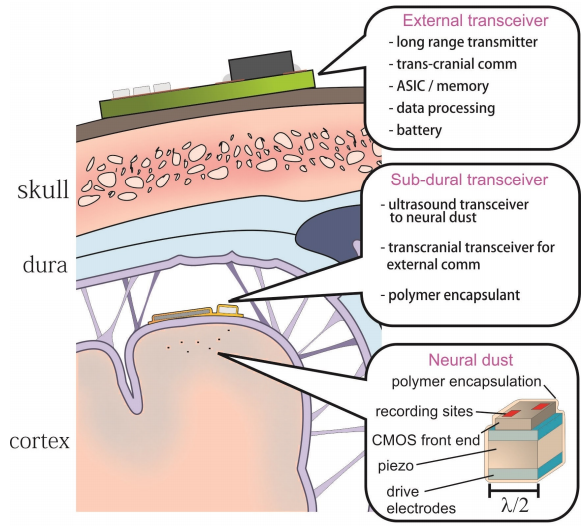In a potential neuroscience breakthrough, University of California Berkeley scientists have proposed a system that allows for thousands of ultra-tiny “neural dust” chips to be inserted into the brain to monitor neural signals at high resolution and communicate data highly efficiently via ultrasound.
The neural dust design promises to overcome a serious limitation of current invasive brain-machine interfaces (BMI): the lack of an implantable neural interface system that remains viable for a lifetime. Current BMI systems are also limited to several hundred implantable recording sites, they generate tissue responses around the implanted electrodes that degrade recording performance over time, and are limited to months to a few years.
Neural dust could also provide the large-scale recording of neurons required for the Brain Research through Advancing Innovative Neurotechnologies (BRAIN) initiative, the scientists suggest.
System Concept

Neural dust system diagram showing the
placement of ultrasonic transceiver under the skull, the neural dust
sensing nodes dispersed throughout the brain, and external transceiver
(credit: Dongjin Seo et al.)
- Thousands of low-power CMOS chips — neural dust — are embedded (via fine-wire arrays that are then removed) into the cortex between neurons. They detect extracellular electrophysiological signals via an electrode and a piezoelectric sensor converts ithe signals into ultrasonic signals.
- A subdural (the dura surrounds the brain and keeps in the cerebrospinal fluid) ultrasonic transceiver (transmitter+receiver) receives ultrasonic signals from the neural dust.It also powers the neural dust with ultrasonic energy.
- A battery-powered external transceiver communicates via ultrasound with the subdural transceiver and transmits the data to an external computer.
The design also uses more efficient “backscatting”: instead of transmitting energy, the chips passively modulate ultrasonic energy from the sub-dural transceiver and reflect it back.
The researchers calculate that the neural dust chips can be as much as 10 million times more efficient that chips using electromagnetics (magnetic or electric signals), which have high attenuation in brain tissue. They would be encapsulated in an inert polymer or insulator film.
The arXiv paper mentions a number of challenges that need to be addressed in developing a practical system.
Remember those slender gleaming spikes Keanu Reeves and pals jacked into the backs of their noggins to go virtual-reality tripping in The Matrix? That’s certainly an image: prong-to-brain networking, your neurons serviced by skewer.
But then the movies — what can you do? The future of brain-machine interfaces may be less, umm, visible if cutting-edge research by scientists at the University of California Berkeley proves viable.
One of the biggest challenges for brain-machine interfaces (BMI) is how to create one you could use indefinitely (like for a lifetime). Even in The Matrix, connecting to the cloud seems awfully inconvenient: sit back in a chair, stab yourself in the skull. Existing real-world BMI systems are clumsier still. As KurzweilAI notes: “Current BMI systems are also limited to several hundred implantable recording sites, they generate tissue responses around the implanted electrodes that degrade recording performance over time, and are limited to months to a few years.”
What if, instead, we built entire armies of tiny dust-sized sensor nodes that could be implanted in the brain (though not autonomously — this isn’t colonize-your-brain-stem time yet) to facilitate communication of whatever sort, in this case keeping high-res tabs on neural signals and relaying data back to aggregation devices via ultrasound?
Here’s how it might work: First you pop through the skull and the brain’s dura (the membrane surrounding the brain), dipping into the brain’s neural sea itself, roughly two millimeters down, where you position thousands of low-powered CMOS chips (the “neural dust,” each as tiny as millionths of a meter) to begin capturing neural signals using electrodes and piezoelectric sensors, which convert the data to ultrasonic signals. Those signals are then picked up by a sub-dural transceiver (sitting just above the “dust” chips and simultaneously powering them ultrasonically), which relays the data to an external transceiver resting just outside the skull (ASIC, memory, battery, long-range transmitter), which in turn communicates wirelessly with whatever computing device.
Like most futurist notions, this one hasn’t been tested yet — it’s just a formal proposal — but it’s another fascinating glimpse into where we might be headed, bypassing clumsy literal BMI head-jacks for micro-scale interfaces that would link us, wire-free, to future galaxies of virtual information.




No comments:
Post a Comment